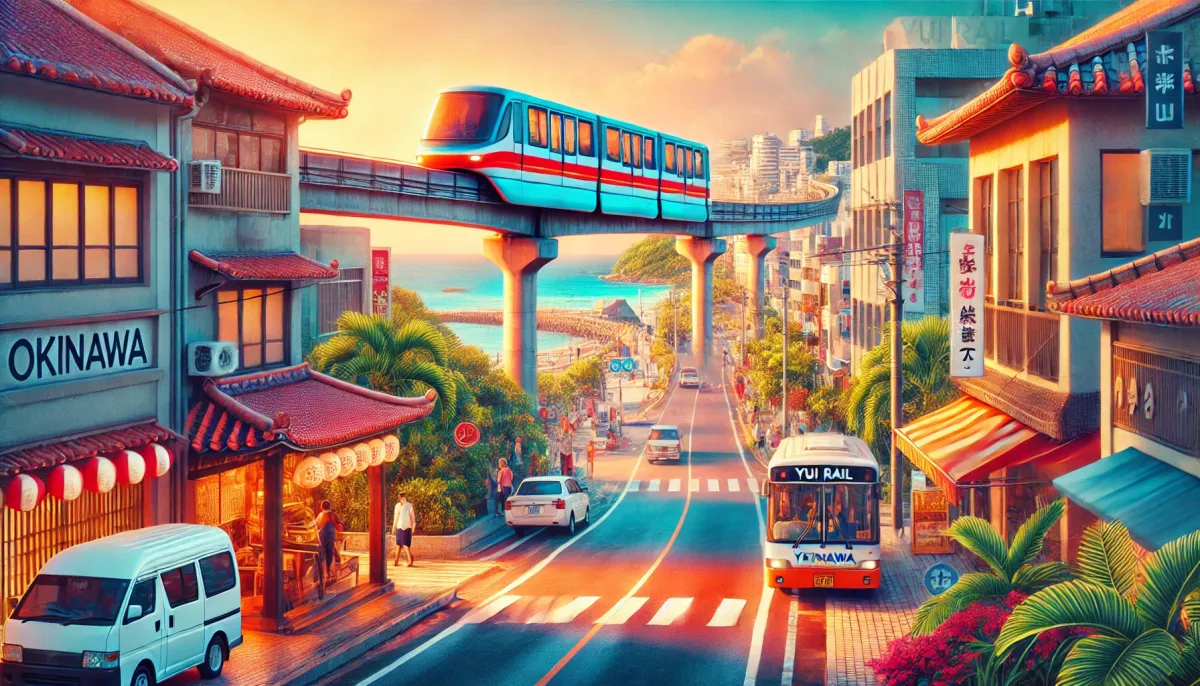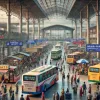Okinawa, a tropical paradise in Japan, often conjures images of scenic coastal drives. But what if driving isn't an option? Fear not, fellow travelers! As an avid backpacker who's explored numerous Asian cities, I'm here to share my experience navigating Okinawa's public transportation system, making it accessible and enjoyable for everyone, especially those visiting from English-speaking countries.
Okinawa's Monorail: Your Urban Expressway
The Okinawa Monorail, or Yui Rail, is the easiest way to travel within Naha and its surrounding areas. Unlike the complex train networks of other Japanese cities, the Yui Rail is a single, straightforward line running from Naha Airport to Shurijo Castle, with stops at key locations like Kokusai Street (International Street) and Oroku.
Right from Naha Airport station, you'll spot the monorail. It's incredibly simple: one line, from Naha Airport to Urasoe-Maeda station. Along the way, it connects you to Shurijo Castle, Kokusai Street, and Oroku. One-day or two-day passes are readily available at station vending machines, simplifying travel further. It's a breeze to purchase – just select your pass and you're good to go!
Beyond the regular passes, consider the OKICA card. While Suica and ICOCA cards work on the monorail, they're not accepted on Okinawa's buses. The OKICA card, purchased at the same vending machines, is your key to seamless bus travel, especially if you plan to combine monorail and bus journeys. I opted for the anonymous version for convenience, but remember, it can't be refunded if lost.
Pro-tip: Download the Japan Transit Planner app. It offers discounted monorail passes, including off-peak and 24-hour options, potentially saving you a couple hundred yen.
Beyond the Monorail: Buses, Limousines, and Airport Shuttles
Okinawa's bus system might seem daunting at first, but with a little guidance, it's entirely manageable. Naha Airport offers limousine buses, highway buses, and regular route buses. While clear signage might be lacking at the airport, a small table near the bus stops indicates the platform for each bus type.
Limousine buses offer direct routes to destinations like Nago and the Churaumi Aquarium. Highway buses, particularly routes 111 and 117, connect to Nago Bus Terminal, while route 117 also goes directly to the aquarium. For destinations further north in the Yanbaru region, look for the Yanbaru Express Bus (YKB).
A dedicated airport shuttle bus (OAS) provides a quicker route to Churaumi Aquarium, with limited daily departures. While these express trips take about 1.5-2 hours, other buses can take up to 3 hours, so plan accordingly. Check the timetables, and remember, most buses don't offer reservations or pre-purchased tickets. It's a first-come, first-served system with on-board payment.
Limousine bus tickets are available at the HIS counter in the domestic terminal and the information counter in the international terminal. At the international terminal's information counter, you can also purchase tickets for the airport shuttle bus and route bus passes. These passes offer cost-effective travel, with one-day and three-day options available, both with and without monorail access. This flexibility is perfect for tailoring your sightseeing plans.
| Pass Type | Description |
|---|---|
| Route Bus Pass (1-day/3-day) | Unlimited rides on route buses (excluding Highway Buses 111 & 117). |
| Combined Pass (1-day/3-day) | Unlimited rides on route buses (excluding Highway Buses 111 & 117) and the Yui Rail monorail. |
| Airport Shuttle Bus Ticket | Direct transportation between Naha Airport and Churaumi Aquarium (discounted round-trip options available). |
Navigating Naha Bus Terminal
For exploring Okinawa via route buses, I highly recommend Naha Bus Terminal. Easily accessible from Asahibashi Station, the terminal is a hub for most city and regional buses. Inside, a clear display board provides route information, including destinations and departure times. Remember, Okinawa's buses are divided into inner-city and outer-city lines, with different fare structures. Inner-city lines (numbers below 20, except 7, 8, and 18) have a flat fare of ¥240, while outer-city lines operate on a distance-based system.
The terminal's information displays make route planning simple. Select your destination (e.g., Shurijo Castle or Kouri Island) and the system will provide the necessary routes, bus numbers, and estimated fares. For navigating Okinawa's bus system, I highly recommend Google Maps or the Japan Transit Planner app – they're lifesavers!
Essential Tools for Okinawa's Public Transport
Three essential tools will enhance your public transportation experience in Okinawa:
- OKICA Card: This rechargeable card simplifies bus travel, as Suica and ICOCA are not accepted on all bus lines.
- OTOPa App: This app allows for online purchase of bus passes, offering convenience and potentially discounted fares.
- Pre-arranged Bus Tours: For a hassle-free experience, consider booking day trips through platforms like KKday or Klook, or directly through local bus companies like Okinawa Bus and Ryukyu Bus. These tours offer curated itineraries, taking you to popular destinations without the need for independent planning.
Two Must-Visit Destinations Accessible by Public Transport
Finally, I want to share two personal favorite spots easily accessible by public transport:
1. Okinawa Convention Center Area: This area offers a trifecta of attractions: a beautiful beach, an indoor entertainment center (ROUND1), and a large supermarket. The ROUND1 complex is a particular highlight, with its Spo-cha section offering a pay-one-price access to a wide range of activities, from arcade games and bowling to sports courts and a manga cafe. It's a fantastic option for escaping the heat or enjoying a rainy day.
2. DMM Kariyushi Aquarium: Located within the iias Okinawa Toyosaki shopping mall, this aquarium provides a more intimate and interactive experience than the larger Churaumi Aquarium. While smaller in scale, it offers unique features like feeding experiences, touch pools, and captivating exhibits, making it a perfect choice for families and those short on time. The surrounding mall and nearby beach add to the appeal, offering shopping and relaxation options.
By embracing these tips and resources, you can unlock the beauty of Okinawa without the need for a car. From the ease of the monorail to the comprehensive bus network, public transportation provides a convenient and affordable way to explore this island paradise. So ditch the car keys, hop on board, and embark on your Okinawan adventure!







